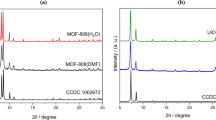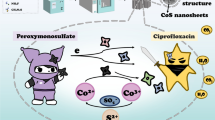Abstract
The current hemodialysis system is not efficient in removing uremic toxins, especially urea. Huge amount of fresh dialysate is required for a dialysis treatment. Poor uremic toxins removal result in toxic waste accumulation in the patients’ bodies, which would lead to cardiovascular diseases and death. Nanoporous materials with excellent pore characteristics and adsorption capacity could be introduced to the hemodialysis system to enhance the urea removal efficiency and regenerate the dialysate. In this study, the viability of using nanoporous materials i.e., oil palm biomass-based activated carbon and mesoporous silica for urea removal was explored. Results indicate that the sulfuric acid-treated activated carbon fiber, palm kernel shell-based activated carbon and amine functionalized silica yielded high urea adsorption capacity. The presence of surface functional groups and excess surface area facilitated the urea adsorption by the synthesized nanoporous materials.






Similar content being viewed by others
References
Abidin, M.N.Z., Goh, P.S., Ismail, A.F., Said, N., Othman, M.H.D., Hasbullah, H., Abdullah, M.S., Ng, B.C., Kadir, S.H.S.A., Kamal, F.: Highly adsorptive oxidized starch nanoparticles for efficient urea removal. Carbohydr. Polym. 201, 257–263 (2018)
Ayyappan, R., Sophia, A.C., Swaminathan, K., Sandhya, S.: Removal of Pb(II) from aqueous solution using carbon derived from agricultural wastes. Process Biochem. 40(3–4), 1293–1299 (2005). https://doi.org/10.1016/j.procbio.2004.05.007
Bansode, R.R., Losso, J.N., Marshall, W.E., Rao, R.M., Portier, R.J.: Adsorption of volatile organic compounds by pecan shell- and almond shell-based granular activated carbons. Bioresour. Technol. 90(2), 175–184 (2003). https://doi.org/10.1016/S0960-8524(03)00117-2
Bhagiyalakshmi, M., Yun, L.J., Anuradha, R., Jang, H.T.: Utilization of rice husk ash as silica source for the synthesis of mesoporous silicas and their application to CO 2 adsorption through TREN/TEPA grafting. J. Hazard. Mater. 175(1), 928–938 (2010)
Cheah, W.-K., Sim, Y.-L., Yeoh, F.-Y.: Amine-functionalized mesoporous silica for urea adsorption. Mater. Chem. Phys. 175, 151–157 (2016)
Cheah, W.K., Othman, R., Yeoh, F.Y.: Organic and inorganic acid activation of activated carbon fiber from palm oil empty fruit bunch. Adv. Mater. Res. 58, 122–130 (2014)
Duranton, F., Cohen, G., De Smet, R., Rodriguez, M., Jankowski, J., Vanholder, R., Argiles, A.: Normal and pathologic concentrations of uremic toxins. J. Am. Soc. Nephrol. 23(7), 1258–1270 (2012)
Feng, Y.Q., Liang, Z.Y., Meng, S.X.: Adsorption of urea nitrogen onto chitosan coated dialdehyde cellulose under biocatalysis of immobilized urease: equilibrium and kinetic. Biochem. Eng. J. 24(1), 65–72 (2005)
Isahak, W.N.R.W., Hisham, M.W.M., Yarmo, M.A.: Highly porous carbon materials from biomass by chemical and carbonization method: a comparison study. J. Chem. 2013, 6 (2012)
Kameda, T., Ito, S., Yoshioka, T.: Kinetic and equilibrium studies of urea adsorption onto activated carbon: adsorption mechanism. J. Dispers. Sci. Technol. 38(7), 1063–1066 (2017)
Liu, J., Chen, X., Shao, Z., Zhou, P.: Preparation and characterization of chitosan/Cu (II) affinity membrane for urea adsorption. J. Appl.Polym. Sci. 90(4), 1108–1112 (2003)
Liu, X., Sun, S., Tang, Y., Li, S., Chang, J., Guo, L.A., Zhao, Y.: Preparation and kinetic modeling of cross-linked chitosan microspheres immobilized Zn (II) for urea adsorption. Anal. Lett. 45(12), 1632–1644 (2012)
Meert, N., Schepers, E., De Smet, R., Argiles, A., Cohen, G., Deppisch, R., Drüeke, T., Massy, Z., Spasovski, G., Stegmayr, B.: Inconsistency of reported uremic toxin concentrations. Artif. Organs 31(8), 600–611 (2007)
Ooi, C.-H., Sim, Y.-L., Yeoh, F.-Y.: Urea adsorption by activated carbon prepared from palm kernel shell. In: AIP Conference Proceedings 2017, p. 020009. AIP Publishing
Singh, C.K., Sahu, J.N., Mahalik, K.K., Mohanty, C.R., Mohan, B.R., Meikap, B.C.: Studies on the removal of Pb(II) from wastewater by activated carbon developed from Tamarind wood activated with sulphuric acid. J. Hazard. Mater. 153(1–2), 221–228 (2008). https://doi.org/10.1016/j.jhazmat.2007.08.043
Terzyk, A.P.: The influence of activated carbon surface chemical composition on the adsorption of acetaminophen (paracetamol) in vitro: part II. TG, FTIR, and XPS analysis of carbons and the temperature dependence of adsorption kinetics at the neutral pH. Colloids Surf. A 177(1), 23–45 (2001)
Wernert, V., Schäf, O., Ghobarkar, H., Denoyel, R.: Adsorption properties of zeolites for artificial kidney applications. Microporous Mesoporous Mater. 83(1–3), 101–113 (2005). https://doi.org/10.1016/j.micromeso.2005.03.018
Xue, C., Wilson, L.D.: Kinetic study on urea uptake with chitosan based sorbent materials. Carbohydr. Polym. 135, 180–186 (2016)
Yeoh, F.-Y., Matsumoto, A., Iwase, Y., Baba, T.: Characterization of acidic property of sulfo-group functionalized microporous and mesoporous silica by adsorption microcalorimetry. Catal. Today 132(1–4), 46–51 (2008)
Zhao, Q., Wang, T., Wang, J., Zheng, L., Jiang, T., Cheng, G., Wang, S.: Template-directed hydrothermal synthesis of hydroxyapatite as a drug delivery system for the poorly water-soluble drug carvedilol. Appl. Surf. Sci. 257(23), 10126–10133 (2011)
Acknowledgement
The authors would like to express their sincere gratitude to the Universiti Sains Malaysia, Ministry of Education Malaysia (MOE), Ministry of Science, Technology and Innovation Malaysia (MOSTI) and My Brain15 program for the financial support provided.
Author information
Authors and Affiliations
Corresponding author
Additional information
Publisher's Note
Springer Nature remains neutral with regard to jurisdictional claims in published maps and institutional affiliations.
Electronic supplementary material
Below is the link to the electronic supplementary material.
Rights and permissions
About this article
Cite this article
Ooi, CH., Cheah, WK. & Yeoh, FY. Comparative study on the urea removal by different nanoporous materials. Adsorption 25, 1169–1175 (2019). https://doi.org/10.1007/s10450-019-00130-5
Received:
Revised:
Accepted:
Published:
Issue Date:
DOI: https://doi.org/10.1007/s10450-019-00130-5




